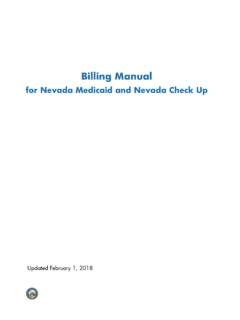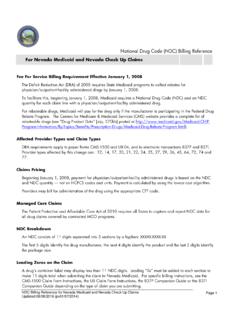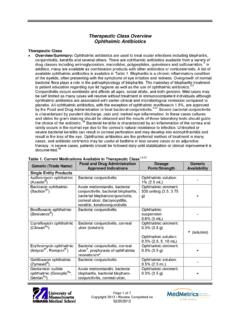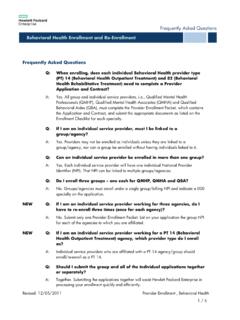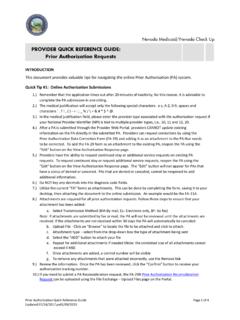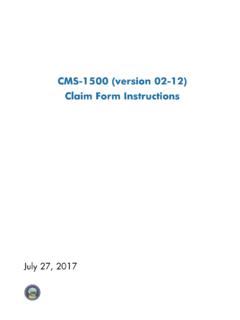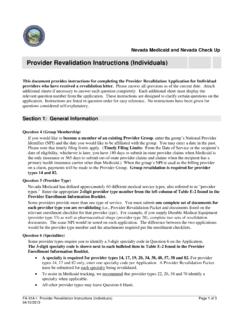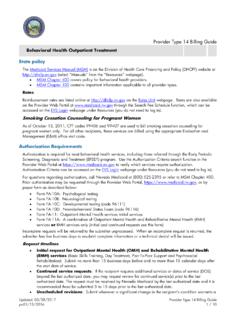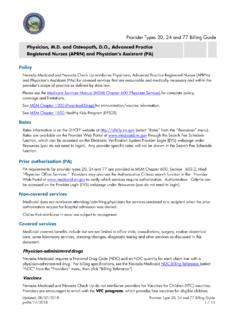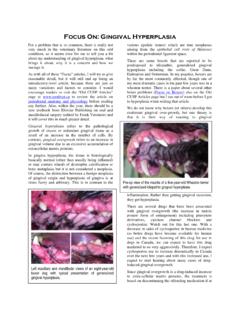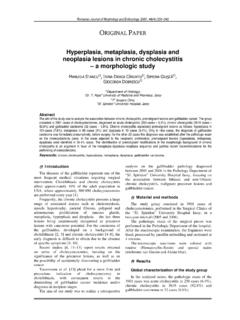Transcription of Therapeutic Class Overview Benign Prostatic …
1 Page 1 o f 6 Copyright 2014 Review Completed on 09/ 22/2014 Therapeutic Class Overview Benign Prostatic Hyperplasia Treatments Therapeutic Class Overview /Summary: The agents approved for the treatment of signs and symptoms of benignprostatic hyperplasia will be the focus of this review. The -adrenergic blockers including, alfuzosin,doxazosin, silodosin, tamsulosin, and terazosin, reduce smooth-muscle tone in the prostate andbladder neck decreasing lower urinary tract symptoms (LUTS) secondary to BPH. Alfuzosin, silodosinand tamsulosin are selective to the -adrenergic receptors located in the prostate and therefore areonly Food and Drug Administration (FDA) approved for BPH, whereas doxazosin and terazosinadditionally inhibit -adrenergic receptors found in the vascular smooth muscle and are additionallyindicated for The 5- reductase inhibitors, dutasteride and finasteride, are appropriatetreatment options for LUTS associated with overall Prostatic enlargement.
2 They act by blocking theconversion of testosterone to dihydrotestosterone and in turn suppress the growth of the ,8 Jalyn (dutasteride/tamsulosin) is a combination of both an -adrenergic blocker and a 5- The final drug approved for use in BPH is the phosphodiesterase-5 inhibitor, tadalafil. Theexact mechanism for reducing BPH symptoms is Note that even though doxazosin andterazosin are FDA-approved for use in the treatment of hypertension, tadalafil is FDA-approved foruse in the treatment of erectile dysfunction and pulmonary arterial hypertension, and finasteride isFDA- approved for alopecia, they are not included in this review. Jalyn (dutasteride/tamsulosin) is acombination of both an - adrenergic blocker and a 5- reductase The final drug approvedfor use in BPH is the phosphodiesterase-5 inhibitor, tadalafil.
3 The exact mechanism for reducing BPHsymptoms is Note that even though doxazosin and terazosin are FDA-approved for use inthe treatment of hypertension, tadalafil is FDA-approved for use in the treatment of erectiledysfunction and pulmonary arterial hypertension and finasteride is FDA-approved for alopecia, theyare not included in this manifestations of BPH include LUTS (frequency of urination, nocturia, hesitancy, urgency, and weak urinary stream). The appearance and progression of symptoms is usually slow, over a couple of years, with a poor correlation between symptoms and the presence of an enlarged prostate on rectal Disease prevalence and the occurrence of symptoms are age dependent, with an initial onset of disease occurring patients greater than 50 years of The American Urological Association (AUA) acknowledges that not all men with histological evidence of BPH will develop bothersome LUTS and not all patients with BPH and LUTS actually have prostate enlargement, one of the main features of symptomatic disease.
4 Additionally, prostate enlargement may exist in the absence of Table 1. Current Medications Available in the Therapeutic Class1-10 Generic (Trade Name) Food and Drug Administration-Approved Indications Dosage Form/Strength Generic Availability Single-Entity Agents Alfuzosin hydrochloride (Uroxatral ) Treatment of signs and symptoms of Benign Prostatic hyperplasia Tablet, extended release: 10 mg Doxazosin mesylate (Cardura , , Cardura XL ) Treatment of signs and symptoms of Benign Prostatic hyperplasia#; treatment of hypertension* Tablet, extended release: 4 mg 8 mg Tablet: 1 mg 2 mg 4 mg Therapeutic Class Overview : Benign Prostatic hyperplasia treatments Page 2 of 6 Copyright 2014 Review Completed on 09/ 22/2014 8 mg Dutasteride (Avodart ) Treatment of signs and symptoms of Benign Prostatic hyperplasia , Capsule: mg - Finasteride (Proscar ) Treatment of signs and symptoms of Benign Prostatic hyperplasia , Tablet: 5 mg Silodosin (Rapaflo ) Treatment of signs and symptoms of Benign Prostatic hyperplasia Capsule: 4 mg 8 mg - Tadalafil (Cialis , Adcirca ) Treatment of signs and symptoms of Benign Prostatic hyperplasia, treatment of erectile dysfunction Tablet.
5 5 10 20 - Tamsulosin hydrochloride (Flomax ) Treatment of signs and symptoms of Benign Prostatic hyperplasia Capsule: mg - Terazosin hydrochloride Treatment of signs and symptoms of Benign Prostatic hyperplasia, Capsule: 1 mg 2 mg 5 mg 10 mg Combination Products Dutasteride/tamsulosin hydrochloride (Jalyn ) Treatment of signs and symptoms of Benign Prostatic hyperplasia , treatment of hypertension Capsule: mg - *Instant release formulation only. In men with an enlarged prostate, to improve symptoms, reduce the risk of acute urinary retention and reduce the risk of the need for BPH-related surgery. To treat symptomatic BPH in men with an enlarged prostate in combination with tamsulosin. To reduce the risk of symptomatic progression of BPH in combination with doxazosin.#Doxazosin indicated for both the urinary outflow obstruction and obstructive and irritative symptoms associated with BPH.
6 Generic available in at least one dosage form or Medicine FDA- approval of silodosin was based on two clinical trials where it was compared to placebo anddemonstrated its efficacy in decreasing the International Prostate Symptom Score (IPSS) andimproving general quality of life scores. In a pooled analysis of these two clinical trials, the meanchange in total IPSS at baseline was ( ) and ( ) for the silodosin and placebogroups, respectively with an adjusted mean difference reported as (P< ). The maximumurinary flow rate (Qmax) at endpoint was mL/second (standard deviation [SD] ) in thesilodosin group and mL/ second (SD ) in the placebo group; corresponding to an adjustedmean group difference of mL/ second (P= ).16 The safety and efficacy of tadalafil for BPH has been evaluated in multiple studies.
7 These consistently showed significantly better improvement in IPSS compared to Onestud y evaluated men with BPH who had comorbid erectile dysfunction. Tadalafil was associated withstatistically significant improvements in both internation index of erectile function (IIEF) scores andtotal IPSS (P< for both).25 Studies comparing the -adrenergic blocking agents to each. Although some trials have suggestedsuperiority one agent over another, most studies, have tended toward non-inferiority within the -blockers related to reducing Cochrane review has evaluated tamsulosin in comparison to other -adrenergic blockingagents. It was concluded that tamsulosin was as effective as other -adrenergic blockers inimproving LUTS and urinary flow rates. Dizziness, rhinitis and abnormal ejaculation occurredTherapeutic Class Overview : Benign Prostatic hyperplasia treatments Page 3 of 6 Copyright 2014 Review Completed on 09/ 22/2014 significantly more frequently than placebo and withdrawal was reported more often with higher doses of tamsulosin.
8 Additionally, terazosin use was associated with a higher rate of discontinuation than low dose oA second Cochrane review evaluated terazosin to other blockers, finasteride alone or incombination with terazosin and placebo. Terazosin was comparable to tamsulosin inimproving IPSS (40% vs 43%), and more effective than finasteride (38% vs 20%) or placebo(38% vs 17%) in improving American Urological Association Symptom Score (AUA -SS) .Peak urinary flow rates were similar among blockers and higher with terazosin (22%) overfinasteride (15%) and placebo (11%).38oA meta -analysis by Djavan et al of -adrenergic blocking agents (alfuzosin, doxazosin,tamsulosin, and terazosin) in men with LUTS suggestive of Benign Prostatic obstruction didnot identify any difference among agents in improving total urinary symptom scores or , alfuzosin and tamsulosin were better tolerated than doxazosin and Similar to the -blocking agents, the 5- reductase inhibitors have been compared to one another in anumber of clinical trials, with mixed results.
9 Dutasteride was shown to be non-inferior to finasteride forreducing prostate volume, post-void volume, and American Urological Association Symptom Score(AUA-SS).47-50 Head-to-head trials between 5- reductase inhibitors and blockers have also been compared to finasteride, tamsulosin showed comparable effect on urinary symptomscores at study end point (24 weeks and 1 year)51,52, however a benefit was found withtamsulosin at earlier assessment (4 weeks) in both IPSS and in combination with dutasteride has been found to be associated with a greaterbenefit in IPSS and Qmax than each agent alone. As expected tamsulosin use resulted in amuch lower decrease in prostate volume as compared to combination therapy ( , respectively; P< ).53,oFour large, long-term trials comparing doxazosin, finasteride, each agent alone and incombination, and Rates of nocturia were significantly reduced with monotherapyand combination treatment compared to with moderate to enlarged prostate glands benefited most from combination therapy(P< ), however doxazosin therapy alone was as effective as combination therapy fordecreasing the risk of progression in men without an enlarged monotherapy and in combination with finasteride was associated with significantlygreater improvements in Qmax and IPSS.
10 Differences between finasteride alone and placebodid not reach statistical use alone and in combination with finasteride was associated with significantlygreater reductions in symptom scores and greater increases in Qmax compared to finasteridemonotherapy or placebo. Differences among combination therapy and terazosinmonotherapy did not reach statistical significance, nor did difference between finasteride Studies have been conducted evaluating the safety and efficacy of combination therapy with twoagents from different retrospective analysis showed that combination therapy with finasteride and an -blockingagent significantly improved IPSS in patients with severe BPH symptoms, but was notstatistically different from monotherapy in the same meta -analysis conducted by Gacci et al found that a phosphodiesterase-5 inhibitor and blocker combination therapy significantly improved IPSS, IIEF score and Qmax compared to ablockers alone (P< , P< and P< , respectively).
